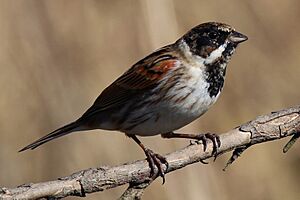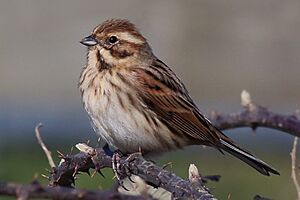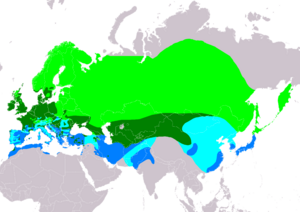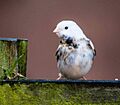Common reed bunting facts for kids
Quick facts for kids Common reed bunting |
|
|---|---|
 |
|
| Male | |
 |
|
| Female – Both at Otmoor, Oxfordshire |
|
| Conservation status | |
| Scientific classification | |
| Subspecies | |
|
|
 |
|
| Range of E. schoeniclus Breeding Resident Passage Non-breeding | |
| Synonyms | |
|
The common reed bunting (Emberiza schoeniclus) is a small passerine bird. It belongs to the bunting family. These birds are often found near water, like in reedbeds.
You can find common reed buntings across Europe and much of Asia. Many of them fly south for winter. However, those living in warmer areas stay put all year. They love places with reeds but can also live in open areas like moorland.
Contents
Understanding the Common Reed Bunting
How Scientists Name Birds: Taxonomy
Scientists give every living thing a special name. This helps everyone know exactly which animal or plant they are talking about. The common reed bunting was first described in 1758 by a Swedish scientist named Carl Linnaeus. He gave it the scientific name Fringilla schoeniclus. Later, it was moved to the group Emberiza.
The word Emberiza comes from an old German word for a bunting. The word schoeniclus comes from an ancient Greek word. It was used for a waterside bird that is now unknown.
Different Types of Reed Buntings: Subspecies
There are many different types, or subspecies, of the common reed bunting. These subspecies live in various parts of the world. For example, the E. s. schoeniclus lives in most of Europe. Other types live in places like Portugal, Italy, Turkey, and even China.
What Does a Common Reed Bunting Look Like?
The common reed bunting is a medium-sized bird. It is about 13.5 to 15.5 centimeters (about 5 to 6 inches) long. It has a strong beak, perfect for eating seeds.
- Males: The male bird has a black head and throat. It also has a white collar around its neck and white underparts. Its back is brown with many streaks.
- Females: The female bird looks much plainer. Her head is streaked brown, and she has more streaks on her underside.
The male's song is a simple, repeated sound that sounds like srip.
Common Reed Bunting Behaviour
What Do They Eat?
Common reed buntings eat different things depending on the time of year. When they are feeding their young, they mostly eat insects. At other times, their main food is seeds.
Life Cycle: How They Reproduce
Common reed buntings usually start breeding in early April. They finish around late August. They are monogamous, meaning one male and one female stay together to raise their young.
The nest is built carefully using small twigs, grass, and reeds. They line it with soft materials like hair, moss, and tiny roots. Nests are usually hidden in a bush or a clump of reeds.
The female lays 4 to 5 olive-grey eggs. These eggs have thin, hair-like markings, which are common for bunting eggs. The eggs hatch after 12 to 15 days. Both parents help feed the baby birds.
How Many Common Reed Buntings Are There?
The common reed bunting is not considered a threatened bird. The IUCN (International Union for Conservation of Nature) lists it as "least concern." This means there are still many of them around.
In Europe, there are at least 4.8 million pairs of these birds. Sweden, Poland, and Norway have many common reed buntings. However, their numbers are decreasing in some countries like Norway, Sweden, Denmark, and Germany.
Gallery








